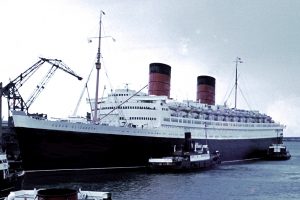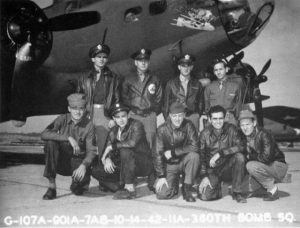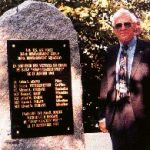
![]() Yesterday, I heard the news that one of the iconic giant sequoia trees, located in Calaveras Big Trees State Park, in California’s Sierra Nevada Mountains, is gone. The tree had been hollowed out to allow cars to drive through it. The Pioneer Cabin Tree, usually referred to as simply the “tunnel tree,” is estimated to be over 1,000 years old. It was knocked over by a powerful winter storm that slammed into California on Sunday. While the tunnel had been carved out of the tree, it was still very much a living tree.
Yesterday, I heard the news that one of the iconic giant sequoia trees, located in Calaveras Big Trees State Park, in California’s Sierra Nevada Mountains, is gone. The tree had been hollowed out to allow cars to drive through it. The Pioneer Cabin Tree, usually referred to as simply the “tunnel tree,” is estimated to be over 1,000 years old. It was knocked over by a powerful winter storm that slammed into California on Sunday. While the tunnel had been carved out of the tree, it was still very much a living tree.
I immediately though back to a vacation my husband, Bob and I took a few years back, that took us through the scenic Redwood National Park in northern California. While the tree that we were able to drive through was not the one that was toppled in this storm, I still felt the loss of that amazing tree. The giant sequoia is the world’s largest tree, after all, and it is only found in the western slopes of the Sierra Nevada Mountains. It can reach a height of 325 feet. This particular tree, called the Pioneer Cabin Tree was actually hollowed out in about 1880. For a long time, cars drove through the iconic tree, but in recent years, it was only accessible by hiking trail. I thought about the tree we drove through, and how much fun it was to see such a huge tree. I was quite saddened by the loss of this beautiful tree.
Apparently, a volunteer, Jim Allday was in the park on Sunday when the tree came crashing down. It was about 2 pm, and the tree splintered on impact. The thing that he found most concerning was that visitors had been walking through the tree just hours earlier. He went out to the site to find the tree on the ground, and what ![]()
![]() looked like a pond or river running through it. The river was most likely the cause of the tree’s demise. The powerful winter storm brought heavy rain and snow to the area. It was the worst flooding in over a decade. The storm forced the closing of Yosemite National Park. It brought with it, hurricane-force winds of over 100 miles per hour. The wind and soggy ground were just too much for the giant tree. For people in the area, and anyone who has ever had the opportunity to see the tree and the park, it feels like losing a famous historical figure, and at 1,000, it was a great historical figure indeed.
looked like a pond or river running through it. The river was most likely the cause of the tree’s demise. The powerful winter storm brought heavy rain and snow to the area. It was the worst flooding in over a decade. The storm forced the closing of Yosemite National Park. It brought with it, hurricane-force winds of over 100 miles per hour. The wind and soggy ground were just too much for the giant tree. For people in the area, and anyone who has ever had the opportunity to see the tree and the park, it feels like losing a famous historical figure, and at 1,000, it was a great historical figure indeed.
 My niece, Gabby Beach, who married my nephew Allen on September 24, 2014, is just wrapping up her service in the Navy. In fact, that is where they met…stationed in Yokosuka, Japan. Theirs was an unusual courtship in that it all happened abroad. The proposal was unusual too, in that it took place in Bali. The whole trip was rather exotic, including riding an elephant. Definitely not your run of the mill proposal.
My niece, Gabby Beach, who married my nephew Allen on September 24, 2014, is just wrapping up her service in the Navy. In fact, that is where they met…stationed in Yokosuka, Japan. Theirs was an unusual courtship in that it all happened abroad. The proposal was unusual too, in that it took place in Bali. The whole trip was rather exotic, including riding an elephant. Definitely not your run of the mill proposal.
After their time in Japan was over, Gabby and Allen were stationed n Washington DC, where she worked in a dental office, but she also worked with service dogs as a volunteer. Now that is far more interesting than dental work, and if you had a chance  to talk to Gabby about that work, as I did, you would know that just the mention of her beloved dogs, makes her beautiful eyes just light up. It didn’t take much imagination to know that those dogs were like children to Gabby, and she totally loves them. It wouldn’t surprise me to hear that she continued to volunteer in the training of service dogs after her time in the service is over, or even if she chose that or something similar as a career for life. To hear her tell about the dogs and what they do, which is to go into hospitals and simply visit the patients. That sounds like such a small thing, but since I have seen such dogs in action in the nursing home where my mother-in-law lives, I can tall you that those dogs are invaluable to the residents there. They have such a wonderful way with them, and they bring joy to each patient they “visit,” because that is what they do, make rounds or visit the patients. It is the sweetest thing I’ve ever seen, and to think that Gabby has helped train them, is really cool. It has to be an amazing feeling.
to talk to Gabby about that work, as I did, you would know that just the mention of her beloved dogs, makes her beautiful eyes just light up. It didn’t take much imagination to know that those dogs were like children to Gabby, and she totally loves them. It wouldn’t surprise me to hear that she continued to volunteer in the training of service dogs after her time in the service is over, or even if she chose that or something similar as a career for life. To hear her tell about the dogs and what they do, which is to go into hospitals and simply visit the patients. That sounds like such a small thing, but since I have seen such dogs in action in the nursing home where my mother-in-law lives, I can tall you that those dogs are invaluable to the residents there. They have such a wonderful way with them, and they bring joy to each patient they “visit,” because that is what they do, make rounds or visit the patients. It is the sweetest thing I’ve ever seen, and to think that Gabby has helped train them, is really cool. It has to be an amazing feeling.

Upon leaving the Navy, Gabby will begin college. I’m not sure what she plans to study, or if they will continue in Washington DC or transfer somewhere else. I know that Texas has been mentioned, but time will tell where they decide to land. For now, a road trip in June to Oregon to watch her younger brother graduate from high school is the first order of business. I also know that the summer months will find Gabby and Allen doing the pastime the love the most…fitness of lots of kinds, but for Gabby, the top activity on her list is rock climbing. No wonder she looks so good. She’s always out there, in search of amazing. Today is Gabby’s birthday. Happy birthday Gabby!! Have a great day!! We love you!!
 My niece, Toni Chase has always been a very industrious person. A while back, Toni started her own eBay store, where she sells vintage jewelry and other vintage items, as well as items she has purchased and added her own special bling to make them a completely new and very unique item. Then she sells these items. Toni is, in many ways, all about vintage. She and her husband, Dave Chase, travel quite a bit, and that gives Toni the opportunity to find many of the unique items she sells. She has an eye for just the right, special item for her siblings too, especially when in comes to clothing, shoes, or handbags. So, when she is shopping for her store, she always keeps an eye out for special gifts for her siblings and mom. That makes her sisters and mom
My niece, Toni Chase has always been a very industrious person. A while back, Toni started her own eBay store, where she sells vintage jewelry and other vintage items, as well as items she has purchased and added her own special bling to make them a completely new and very unique item. Then she sells these items. Toni is, in many ways, all about vintage. She and her husband, Dave Chase, travel quite a bit, and that gives Toni the opportunity to find many of the unique items she sells. She has an eye for just the right, special item for her siblings too, especially when in comes to clothing, shoes, or handbags. So, when she is shopping for her store, she always keeps an eye out for special gifts for her siblings and mom. That makes her sisters and mom  very blessed when it comes to birthdays and Christmas, and just because. They always know that Toni will find the very coolest things for them. I have even been the recipient of a pair of super cute books that She knew would be perfect for me.
very blessed when it comes to birthdays and Christmas, and just because. They always know that Toni will find the very coolest things for them. I have even been the recipient of a pair of super cute books that She knew would be perfect for me.
In addition to her eBay store, Toni also works a full time job. Talk about staying busy…that’s Toni for sure. With her eBay business, traveling, hiking with her husband and son, James Renville, and working full time, I’m surprised that she has any time to sleep. Toni has enlisted the help of her husband, Dave in part of her business too. He helps with packing and I’m sure he is her main runner, but what would a business do without the errand runners. And Dave doesn’t mind helping out, so that’s great.
Toni has always had a soft heart and especially where people are concerned. I think that if Toni could, she  would give her family and friends the moon, but unfortunately, that isn’t something she can do right now, maybe after she wins the lottery…right!! If I know Toni, that wouldn’t be too far from the truth. Toni is a loving person, who is always pleasant to be around. She always wears a smile, and is loved by all who know her. When I saw a saying my friend posted on Facebook, it immediately reminded me of Toni. It went like this, “I’m not impressed by money, social status, or job title, but by the way someone treats other human beings.” I think that says it all. Toni treats human beings as if they were all her family. It makes her who she is. She is perfect, just the way she is. Today is Toni’s birthday. Happy birthday Toni!! Have a great day!! We love you!!
would give her family and friends the moon, but unfortunately, that isn’t something she can do right now, maybe after she wins the lottery…right!! If I know Toni, that wouldn’t be too far from the truth. Toni is a loving person, who is always pleasant to be around. She always wears a smile, and is loved by all who know her. When I saw a saying my friend posted on Facebook, it immediately reminded me of Toni. It went like this, “I’m not impressed by money, social status, or job title, but by the way someone treats other human beings.” I think that says it all. Toni treats human beings as if they were all her family. It makes her who she is. She is perfect, just the way she is. Today is Toni’s birthday. Happy birthday Toni!! Have a great day!! We love you!!
 On September 27, 1938, the largest passenger ship of its time, the Queen Elizabeth, named after the wife of King George VI was launched. The ship was the epitome of luxury. And those fortunate enough to sail on it were treated to every luxury imaginable, at least until World War II came about. When World War II began, the Queen Elizabeth was sent to New York to protect it from German bombs. It was docked next to the Normandie and the Queen Mary, the other two largest passenger ships of the time. As the war progressed, the Queen Elizabeth was called into service as a troop transport ship. It carried nearly 1 million soldiers before the war ended. After the war, the ship returned to commercial service and became one of the dominant transatlantic carriers, hauling thousands of people back and forth between England and the United States. It was once again doing the work it was designed for.
On September 27, 1938, the largest passenger ship of its time, the Queen Elizabeth, named after the wife of King George VI was launched. The ship was the epitome of luxury. And those fortunate enough to sail on it were treated to every luxury imaginable, at least until World War II came about. When World War II began, the Queen Elizabeth was sent to New York to protect it from German bombs. It was docked next to the Normandie and the Queen Mary, the other two largest passenger ships of the time. As the war progressed, the Queen Elizabeth was called into service as a troop transport ship. It carried nearly 1 million soldiers before the war ended. After the war, the ship returned to commercial service and became one of the dominant transatlantic carriers, hauling thousands of people back and forth between England and the United States. It was once again doing the work it was designed for.
In 1968, the ship’s owner, the Cunard Steamship Company, sold the Queen Elizabeth. The purchasing company planned to make it a tourist attraction and hotel in Philadelphia. The plans were scrapped when the aging ship was deemed a fire hazard. Two years later it was sold to Hong Kong businessman CY Tung, who wanted to use the ship as a floating college. Tung renamed the ship, Seawise University and sent it to Hong Kong Harbor for refitting. On January 9, 1972, as the ship neared the completion of the £5 million conversion, it caught fire. The fire was thought by some to have been arson, because several blazes broke out simultaneously throughout the ship. The fact that CY Tung had acquired the vessel for $3.5 million, and had insured it for $8 million, led some to speculate that the inferno was part of a fraud to collect on the insurance claim. Others speculated that the  fires were the result of a conflict between Tung, a Chinese Nationalist, and Communist-dominated ship construction unions. Virtually, the entire Hong Kong firefighting force turned out to try to save the ship, but despite their heroic efforts over two long days, the ship turned on its side and sank to the bottom of the harbor, which was apparently not very deep, because over half of the ship could be seen above the water until it was dismantled and sold for scrap between 1974 and 1975, because it had been deemed a shipping hazard. Fortunately, no one was killed in the fire. Shortly before it was scrapped, the wreck served as the backdrop for a key scene in The Man With the Golden Gun, a 1974 James Bond film starring Roger Moore.
fires were the result of a conflict between Tung, a Chinese Nationalist, and Communist-dominated ship construction unions. Virtually, the entire Hong Kong firefighting force turned out to try to save the ship, but despite their heroic efforts over two long days, the ship turned on its side and sank to the bottom of the harbor, which was apparently not very deep, because over half of the ship could be seen above the water until it was dismantled and sold for scrap between 1974 and 1975, because it had been deemed a shipping hazard. Fortunately, no one was killed in the fire. Shortly before it was scrapped, the wreck served as the backdrop for a key scene in The Man With the Golden Gun, a 1974 James Bond film starring Roger Moore.

 When my grandson, Caalab Royce was a little boy, he was obsessed with being “older” than me…or anyone else for that matter. He would often come up to me or other people and say, “I’m older than you.” It was always such a funny thing to have this little tiny, under five year old boy telling me that he was older than me…his grandma. It always made me smile, and maybe that was his plan anyway. He is, after all, a comedian…always had been. Not everyone was happy with his little joke, especially his older sister, Shai Royce. She was living behind the age eight ball anyway, because she was a Leap Day Baby. So the reality is that by the time he was one, he technically was older than she was. It was a source of contention, until I finally told her that she might only be two at eight, but she would get to drive when she was four and her brother and cousins would have to wait until they were sixteen, so it all evened out in the end.
When my grandson, Caalab Royce was a little boy, he was obsessed with being “older” than me…or anyone else for that matter. He would often come up to me or other people and say, “I’m older than you.” It was always such a funny thing to have this little tiny, under five year old boy telling me that he was older than me…his grandma. It always made me smile, and maybe that was his plan anyway. He is, after all, a comedian…always had been. Not everyone was happy with his little joke, especially his older sister, Shai Royce. She was living behind the age eight ball anyway, because she was a Leap Day Baby. So the reality is that by the time he was one, he technically was older than she was. It was a source of contention, until I finally told her that she might only be two at eight, but she would get to drive when she was four and her brother and cousins would have to wait until they were sixteen, so it all evened out in the end.
Caalab has long since ceased to be that little boy trying so hard to be older, and I haven’t heard that funny little comment in a long time, but the story lives on in my memory files. Now that he is going on twenty years old this summer, I guess being older is not so important anymore. And, at almost twenty one…or 5¼…Shai is no longer bothered by such comments. I think that I just assumed that those days of hearing the comment, “I’m older than you” were over. How wrong I was.
Flash forward now those eighteen plus years, to my niece Kellie Hadlock, who is also a serious comedian…if that is possible, and you have Kelli calling me, my daughters, Corrie Petersen and Amy Royce, and most of the rest of the girls in the family, Little Baby Caryn…or whatever their name might be. That is because Kellie is 6’0″, compared to my 5’2″. Kellie likes to hugs us and lift us off our feet at the same time, to make a point that we are vertically challenged. Today in church, where Kellie, her mom, my sister, Allyn Hadlock, and I are all 
 backup singers, Kellie greeted me with her usual, “Hi, little baby Caryn.” I called her little baby Kellie, to which she giggled, “I don’t think so.” I told her that since I am older than her, she will always be little baby Kellie to me. Then, straight out of the past, came the sentence I thought I was done hearing, when Kellie said, “I’m older than you!” The shock must have registered on my face, because my sister said, “That would be ok!” I had to agree, because since I’m sixty and Kellie is almost twenty seven. I could handle being twenty six…or, maybe not, but it was a funny blast from the past.
backup singers, Kellie greeted me with her usual, “Hi, little baby Caryn.” I called her little baby Kellie, to which she giggled, “I don’t think so.” I told her that since I am older than her, she will always be little baby Kellie to me. Then, straight out of the past, came the sentence I thought I was done hearing, when Kellie said, “I’m older than you!” The shock must have registered on my face, because my sister said, “That would be ok!” I had to agree, because since I’m sixty and Kellie is almost twenty seven. I could handle being twenty six…or, maybe not, but it was a funny blast from the past.

 Lots of kids love to spend the night with their grandparents, and my grand niece, Siara Harman was no different. Lots of girls are drama queens too, and again, my grand niece, Siara was no different. What was different was that Siara was a drama queen and grandma’s girl at the tender age of just two years. Siara and her grandma, my sister, Cheryl Masterson loved to spend time together, but with Cheryl working, they were more limited to the weekends. Problem solved…almost every Friday, Cheryl would have Siara spend the weekend with her. Siara loved it. She would come in the house, and immediately get comfortable, by stripping right down to her undies, something lots of kids find the most comfortable. Who needs clothes anyway…right.
Lots of kids love to spend the night with their grandparents, and my grand niece, Siara Harman was no different. Lots of girls are drama queens too, and again, my grand niece, Siara was no different. What was different was that Siara was a drama queen and grandma’s girl at the tender age of just two years. Siara and her grandma, my sister, Cheryl Masterson loved to spend time together, but with Cheryl working, they were more limited to the weekends. Problem solved…almost every Friday, Cheryl would have Siara spend the weekend with her. Siara loved it. She would come in the house, and immediately get comfortable, by stripping right down to her undies, something lots of kids find the most comfortable. Who needs clothes anyway…right.
Siara and her grandma would do lots of things, like watch movies, play games, and read books. Of course, there were the aunts and uncle there too, because they were just barely in double digit ages themselves. That made it lots of fun too, because Siara had lots of kids to play with. Nevertheless, it was her grandma that Siara really came to see. They were best friends, and even though Siara is 23 years old now, they are just as close today, although Siara doesn’t spend the night any more. Siara loved sleeping with grandma those days, and even liked hanging out in Grandma’s bed during the day. It was their way of having a lazy girls weekend. I wish I could spend the day in bed sometimes. Of course, Cheryl couldn’t spend the day there, during the day, it was mostly just Siara…chillin’…for a few minutes anyway, until she went to see what her friend, i.e. grandma was up to, because that was more interesting, after all.
When Sunday morning rolled around, it was time to go to church, and Siara liked that as much as any other part of the weekend. The problem occurred after church…when it was time to go home. Her mom, Chantel would come to pick her up, and the drama queen came out. When she was told that it was time to go home, Siara would slump down in her chair, with her head flopping down in an exaggerated show of utter devastation, and yell, “It’s only been a minute!!!” My niece, Chantel Balcerzak, Siara’s mom, said, “No baby, you have been here all weekend.” Again, Siara would yell, “No!!! It’s only been a minute!!! Now for a grandmother, that kind of display immediately tears at your heart. Cheryl would say, “Can’t you come back later and get her?” Chantel mostly said that Siara had spent enough time, but sometimes she would give in, or Cheryl would agree to bring 
 Siara home later. The thing is, it wasn’t a tantrum, that made Siara argue about the time to go home, but rather that she loved her grandma so much, and she hated to leave, because it seemed an eternity until the next time she got to come over. Of course, she loved her family too, but her grandma time was special, and after all, it had only been a minute since she got there. It couldn’t be time to go home already. Time flies when you are having fun, and I think most of us can relate to Siara’s thinking on the matter. Today is Siara’s birthday. Happy birthday Siara!! Have a great day!! We love you!!
Siara home later. The thing is, it wasn’t a tantrum, that made Siara argue about the time to go home, but rather that she loved her grandma so much, and she hated to leave, because it seemed an eternity until the next time she got to come over. Of course, she loved her family too, but her grandma time was special, and after all, it had only been a minute since she got there. It couldn’t be time to go home already. Time flies when you are having fun, and I think most of us can relate to Siara’s thinking on the matter. Today is Siara’s birthday. Happy birthday Siara!! Have a great day!! We love you!!
 My grand nephew, Ethan Hadlock, who is the son of my nephew Ryan Hadlock and his wife, Chelsea, is such a sweet boy. I had the chance to talk to my sister, Alena Stevens, who works at Verda James Elementary School, where Ethan and his sister Aurora go to school, and I asked her about Ethan from a school perspective…not because I expected him to be very different than he is at home, but because she would see him from a different perspective than his parents or grandparents. What she told me, was a very nice, pleasant surprise, in a way, and yet, not totally unexpected, because as she told me about it, I could totally see Ethan in her words.
My grand nephew, Ethan Hadlock, who is the son of my nephew Ryan Hadlock and his wife, Chelsea, is such a sweet boy. I had the chance to talk to my sister, Alena Stevens, who works at Verda James Elementary School, where Ethan and his sister Aurora go to school, and I asked her about Ethan from a school perspective…not because I expected him to be very different than he is at home, but because she would see him from a different perspective than his parents or grandparents. What she told me, was a very nice, pleasant surprise, in a way, and yet, not totally unexpected, because as she told me about it, I could totally see Ethan in her words.
Alena told me that Ethan is a good boy, and a good student, a fact that was corroborated by his mother’s words that he is rated as exceptional in his class in reading and math. For a parent, hearing that your children are well behaved and well liked in school, is quite  rewarding, because it speaks to their parenting skills. Ryan and Chelsea are good parents, and they have raised beautiful, loving children. Alena told me that he made friends quickly and easily, when he came to Verda James, and as anyone who has changed schools before will tell you, making new friends can be hard. Not for Ethan though. He is just such a pleasant, kind, and well behaved boy, that kids are naturally drawn to him. Ethan is always cheerful, and as I said, kind, and one thing that sometimes doesn’t happen…good to his little sister. He always makes sure that she is where she needs to be, and that she has everything she needs. You often see a little girl who motherly, but boys don’t always take the time to help their younger siblings. Ethan is an exception to that rule. As much as he is all boy, he is still good to Aurora, and that makes his stand out to those adults, and children too, around him. Ethan is starting to get into Lego Robotics, and really loves it. He still loves Star Wars, and enjoys playing Minecraft too.
rewarding, because it speaks to their parenting skills. Ryan and Chelsea are good parents, and they have raised beautiful, loving children. Alena told me that he made friends quickly and easily, when he came to Verda James, and as anyone who has changed schools before will tell you, making new friends can be hard. Not for Ethan though. He is just such a pleasant, kind, and well behaved boy, that kids are naturally drawn to him. Ethan is always cheerful, and as I said, kind, and one thing that sometimes doesn’t happen…good to his little sister. He always makes sure that she is where she needs to be, and that she has everything she needs. You often see a little girl who motherly, but boys don’t always take the time to help their younger siblings. Ethan is an exception to that rule. As much as he is all boy, he is still good to Aurora, and that makes his stand out to those adults, and children too, around him. Ethan is starting to get into Lego Robotics, and really loves it. He still loves Star Wars, and enjoys playing Minecraft too.
 Probably the most surprising thing that my sister told me was the little story about the Book Fair. She told me that Ethan doesn’t like to burden anyone. He wanted a book from the Book Fair, but didn’t want to bother his mom by asking for the money. He kept bringing what he had from home not knowing it wasn’t enough. Nevertheless, he tried to get a little more money and even brought in a gift card he had received. The librarian felt so bad that he didn’t have enough, so she just took what he had and gave him the book. Knowing his parents, as we do, we know that his mom would have gladly given him the money, but he just didn’t want to burden her. What a kind, loving boy!! Today is Ethan’s 8th birthday. Happy birthday Ethan!! You are never a burden!! Have a great day!! We love you!!
Probably the most surprising thing that my sister told me was the little story about the Book Fair. She told me that Ethan doesn’t like to burden anyone. He wanted a book from the Book Fair, but didn’t want to bother his mom by asking for the money. He kept bringing what he had from home not knowing it wasn’t enough. Nevertheless, he tried to get a little more money and even brought in a gift card he had received. The librarian felt so bad that he didn’t have enough, so she just took what he had and gave him the book. Knowing his parents, as we do, we know that his mom would have gladly given him the money, but he just didn’t want to burden her. What a kind, loving boy!! Today is Ethan’s 8th birthday. Happy birthday Ethan!! You are never a burden!! Have a great day!! We love you!!
 As the door closes on past eras of history, some things only exist in the memories of the people who lived it, and some things only exist in books or other writings. That doesn’t mean that they totally cease to exist, however. There are parts of the past that are still there…hidden, sometimes just under the surface, and sometimes a little way beneath the surface. Sometimes, there are clues on the surface, and other times, all you might have is a general location. Such is the case with Fort San Juan in western North Carolina. In 1566, Spanish explorer Juan Pardo began the first of two expeditions along the southeast coast of North America, establishing a series of forts in modern day South Carolina. The following year, Pardo travelled west, journeying almost 300 miles into what is now North Carolina. There, Pardo and his men constructed Fort San Juan and a small cluster of houses. Pardo named the settlement Cuenco, after his Spanish hometown.
As the door closes on past eras of history, some things only exist in the memories of the people who lived it, and some things only exist in books or other writings. That doesn’t mean that they totally cease to exist, however. There are parts of the past that are still there…hidden, sometimes just under the surface, and sometimes a little way beneath the surface. Sometimes, there are clues on the surface, and other times, all you might have is a general location. Such is the case with Fort San Juan in western North Carolina. In 1566, Spanish explorer Juan Pardo began the first of two expeditions along the southeast coast of North America, establishing a series of forts in modern day South Carolina. The following year, Pardo travelled west, journeying almost 300 miles into what is now North Carolina. There, Pardo and his men constructed Fort San Juan and a small cluster of houses. Pardo named the settlement Cuenco, after his Spanish hometown.
In 2013, a team of archeologists announced the discovery of the remains of a long lost 16th century Spanish garrison in western North Carolina that predates the earliest English settlements in North America by decades. Established in 1567, Fort San Juan was just one of at least six military installations built by the Spanish across the Appalachian mountain range, stretching from the coast of South Carolina to eastern Tennessee, and the only one of the forts scientists have located so far. Because Fort San Juan was established in 1567, time had taken its toll, and the information about it’s location was scarce, as was any visible trace of its location. Fort San Juan was one of at least six military installations that were built by the Spanish across the Appalachian mountain range, stretching from the coast of South Carolina to eastern Tennessee…and the only one of the  forts scientists have been able to locate so far. In the summer of 2013, a team of archeologists announced the discovery of the fort’s remains.
forts scientists have been able to locate so far. In the summer of 2013, a team of archeologists announced the discovery of the fort’s remains.
Archaeological work has been underway for years, revealing artifacts that suggested a Spanish settlement might have been there. During the summer of 2013, archaeologists affiliated with the University of Michigan, Tulane University and Warren Wilson College excitedly announced that they had discovered evidence of a defensive moat and other remains, definitive evidence of Fort San Juan. Nearly a decade ago, archeologists had found evidence of the soldier’s housing at Cuenco, but had been had not been able to locate the fort itself. The summer of 2013 changed all that, and was in fact it was completely by accident. The team, comprised of members from the University of Michigan, New Orleans’s Tulane University and Warren Wilson College in Asheville, North Carolina, was actually researching the Mississippian built mud mounds at the Joara site when they stumbled upon evidence of the remains of the fort. An initial dig turned up soil disturbances at the site that didn’t fit with what they expected. The team brought in a magnetometer to x-ray the subsurface. This  allowed them to identify the outlines of the moat was believed to have surrounded the garrison. Additional large scale excavations revealed its shape and size. A V-shaped area 5.5 feet deep, 12 to 15 feet across and up to 100 feet in length. In addition to the moat, the team recovered personal items belonging to the Spanish soldiers who lived and died at the fort, including pottery shards, nails, tacks, and iron hooks used for fastening clothing and swords. They also believe they located the gravel entry path into the garrison and the possible location of the strong house in a corner of the fort, where Spanish soldiers would have stored tools and weaponry. The group plans further excavations of the site next year.
allowed them to identify the outlines of the moat was believed to have surrounded the garrison. Additional large scale excavations revealed its shape and size. A V-shaped area 5.5 feet deep, 12 to 15 feet across and up to 100 feet in length. In addition to the moat, the team recovered personal items belonging to the Spanish soldiers who lived and died at the fort, including pottery shards, nails, tacks, and iron hooks used for fastening clothing and swords. They also believe they located the gravel entry path into the garrison and the possible location of the strong house in a corner of the fort, where Spanish soldiers would have stored tools and weaponry. The group plans further excavations of the site next year.

 Have you ever wondered why US money is green…or mostly green, while the money of so many other countries is very colorful? How did paper money come about anyway? Actually, paper money has been around in the United States since the beginning, off and on anyway. Printing paper money has been a controversial practice over the years. In 1861, as a means of financing the American Civil War, the federal government began issuing paper money for the first time since the Continental Congress printed currency to help pay for the Revolutionary War. The earlier form of paper dollars, dubbed continentals, were produced in such high volume that they soon lost much of their value. Devaluing our money has been a long standing problem with paper money. It’s simply too easy to print more money than we have gold to back.
Have you ever wondered why US money is green…or mostly green, while the money of so many other countries is very colorful? How did paper money come about anyway? Actually, paper money has been around in the United States since the beginning, off and on anyway. Printing paper money has been a controversial practice over the years. In 1861, as a means of financing the American Civil War, the federal government began issuing paper money for the first time since the Continental Congress printed currency to help pay for the Revolutionary War. The earlier form of paper dollars, dubbed continentals, were produced in such high volume that they soon lost much of their value. Devaluing our money has been a long standing problem with paper money. It’s simply too easy to print more money than we have gold to back.
In the decades before the Civil War, private, state chartered banks printed the paper money. Not surprisingly, this resulted in a wide variety of denominations and designs. Apparently, there was no real decision on how this should look. I guess they weren’t really worried about counterfeiting at that time. The bills that came out in the 1860s became known as greenbacks, because their backsides were printed in green ink. This ink was used as an anti-counterfeiting measure used to prevent photographic knockoffs, since the cameras of the time could only take pictures in black and white. I guess that counterfeiting had become a problem in the earlier years after all. And as we all know, the new scanners continue to improve the possibility of counterfeiting, making watermarks and security strips necessary too. And they have also added color to the money these days.
In 1929, the federal government decided that the paper money was too expensive to print, so in an effort to cut costs, they shrunk the size of all paper money. At the same time, they standardized the designs for each denomination, which made it easier for people to tell the difference between real and counterfeit bills. The new, more compact bills continued to be printed in green ink, because according to the US Bureau of Printing and Engraving, the ink was readily available and durable. They also thought that the color green represented stability. Today, there is some $1.2 trillion in coins and paper money in circulation in America. It costs about 5 cents to produce every $1 bill and around 13 cents to make a $100 bill, the highest denomination currently in 
 circulation. Don’t ask me why the difference, I would have expected them to be pretty much the same cost to manufacture. The estimated life span of a $1 bill is close to six years, while a $100 bill typically lasts 15 years, which makes sense to me, because we don’t use the $100 bill nearly as much. The $50 bill has the shortest average life span, at 3.7 years, and I would have expected the shortest lifespan to be the $1 bill, because we us those all the time.
circulation. Don’t ask me why the difference, I would have expected them to be pretty much the same cost to manufacture. The estimated life span of a $1 bill is close to six years, while a $100 bill typically lasts 15 years, which makes sense to me, because we don’t use the $100 bill nearly as much. The $50 bill has the shortest average life span, at 3.7 years, and I would have expected the shortest lifespan to be the $1 bill, because we us those all the time.

 Every war has its casualties…it is an inevitable part of battle. World War II was no different, and in fact it was the deadliest war in world history, with casualties between 40,000,000 and 72,000,000. On average, 6,600 American servicemen died per month during World War II, about 220 a day. By the end of the war, over 40,000 airmen were killed in combat theatres and another 18,000 wounded. Some 12,000 missing men were declared dead, including a number liberated by the Soviets but never returned. More than 41,000 were captured, half of the 5,400 held by the Japanese died in captivity, compared with one tenth in German hands. As with any part of the war, being an airman in World War II was simply a very dangerous business.
Every war has its casualties…it is an inevitable part of battle. World War II was no different, and in fact it was the deadliest war in world history, with casualties between 40,000,000 and 72,000,000. On average, 6,600 American servicemen died per month during World War II, about 220 a day. By the end of the war, over 40,000 airmen were killed in combat theatres and another 18,000 wounded. Some 12,000 missing men were declared dead, including a number liberated by the Soviets but never returned. More than 41,000 were captured, half of the 5,400 held by the Japanese died in captivity, compared with one tenth in German hands. As with any part of the war, being an airman in World War II was simply a very dangerous business.
Over the years of World War II, there were many stories of men falling from their planes either from attack or accident. I’m sure some were just stories, but this is a true story. Staff Sergeant Alan Magee was born on January 13, 1919 in Plainfield, New Jersey, the youngest of six children of Resue and Doretta (Winn) Magee. Alan grew to be a short 5’7″ tall. That is short for a man, but slightly tall for a ball turret gunner on a B-17 bomber. Like many men, Alan joined the service right after the attack on Pearl Harbor. He was assigned as a ball turret gunner with the 303rd Bomb Group, 360th Squadron stationed at RAF Molesworth, which is a Royal Air Force station located near Molesworth, Cambridgeshire, England.
At 5’7″ inches, Magee was barely small enough to fit in the B-17’s ball turret. The ball turret was a cramped, donut shaped plastic glass and metal turret on the belly of the bomber. It was such a tight fit that a gunner’s knees were practically against his chest. Magee had to leave his parachute on the deck of the four engine Flying Fortress. That fact would prove to be detrimental. On January 3, 1943, Magee was assigned to a B-17, nicknamed “Snap! Crackle! Pop!” They were on a bombing run during the daytime over Saint Nazaire, France, also known at “Flack City,” when German fighters shot off a part of the right wing, causing the plane to enter a deadly spin. This was Magee’s seventh mission. That was an amazing feat in and of itself, because the life expectancy of a ball turret gunner in World War II was 12 minutes. It was really considered a suicide position on the plane. Oddly too, Magee was one of the oldest members of the 10 man crew at 24 years. The pilot, Captain Arthur Adams, was only 19, and this was only his third combat mission.
Magee was wounded in the attack, but managed to escape the ball turret, scrambling back into the cabin for his parachute. The only problem was that his parachute had been damaged and was totally useless, so having no other choice, Magee leapt from the spiraling plane without his parachute, losing consciousness rapidly because of the altitude. During his fall from the plane, Magee asked God to save his life. “I don’t wish to die because I know nothing of life,” was his appeal to God. Then, he totally lost consciousness and crashed through the glass roof of the Saint Nazaire train station. Eyewitnesses watched in horror as Magee came through the skylight. When he regained consciousness, Magee said to his captors: “Thank God I’m alive.” Magee’s injuries included 28 shrapnel wounds. A lung and kidney were hit. His nose and an eye were ripped open. His broken bones included his right leg and ankle. A right arm was nearly severed. The Germans decided that anyone who could miraculously survive such a fall deserved “real special attention.” It is thought that he fell over four miles before crashing through the glass roof. Some said they thought that the glass roof lessened Magee’s impact, and rescuers found him still alive on the floor of the station. It is my belief that God sent His angels to break the fall, because a 20,000 foot into a soft field can be fatal, so it is a miracle that he fell through a glass roof onto a concrete floor and lived. Magee regained consciousness in the first aid station before being transferred to the local hospital. “I owe the German military doctor who treated me a debt of gratitude,” said Magee. “He told me, ‘We are enemies, but I am first a doctor and I will do my best to save your arm.’” The doctor saved Magee’s arm and tended his other injuries, but unfortunately, Magee never found out the doctor’s name, so he couldn’t thank him. Staff Sargent Magee was taken as a POW and given continued medical treatment for his injuries by his captors. Magee was rescued in May 1945, and received the Air Medal for meritorious conduct and the Purple Heart. When the war was over, Magee got his pilot’s license and enjoyed flying. He worked a variety of jobs in the airline industry, and retired in 1979. He then moved to Northern New Mexico.

 The people of Saint Nazaire, France honored Magee and the crew of his bomber on January 3rd, 1993 by erecting a six foot tall memorial to them. Alan Magee passed away in San Angelo, Texas on December 20th, 2003, at 84 from stroke and kidney failure. With the German doctors’ help, Magee fully recovered. Magee later hiked and backpacked and “led a pretty good life.” Two of his crewmen also survived. In all, 75 airmen died, seven U.S. planes were destroyed and 47 were damaged that day.
The people of Saint Nazaire, France honored Magee and the crew of his bomber on January 3rd, 1993 by erecting a six foot tall memorial to them. Alan Magee passed away in San Angelo, Texas on December 20th, 2003, at 84 from stroke and kidney failure. With the German doctors’ help, Magee fully recovered. Magee later hiked and backpacked and “led a pretty good life.” Two of his crewmen also survived. In all, 75 airmen died, seven U.S. planes were destroyed and 47 were damaged that day.

